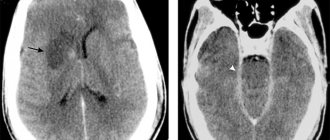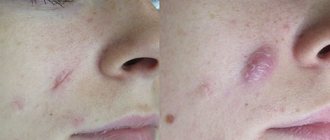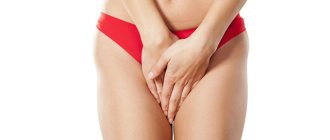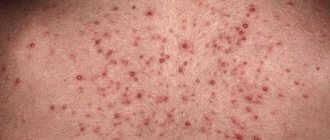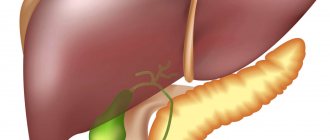Dermographism is a response of subcutaneous vessels to tactile irritation of the skin, which can be caused by applying streak movements with a blunt-pointed stick. It turns out that dermographism is normally detected in 98% of the world's population. Its definition has an important diagnostic role in the study of disorders of the nervous system, and more specifically, the autonomic system (ANS). During examination, the surface of the skin at the site of irritation first becomes white, and after 9-20 seconds it turns red due to the expansion of subcutaneous capillaries. The color and width of the dermographism strip depends on the tone of the ANS. Stripes of dermographism in a healthy person persist for a short time, should not be accompanied by itching, the formation of edematous stripes, or rise above the level of the skin. The time interval of dermographism can vary from 8 seconds to 20 minutes. Sometimes dermographism occurs as a pathological reaction. Therefore, it is necessary to attach significance only in cases of its sharp deviation, namely, an increase in color intensity or its absence. Also, the response of skin capillaries may depend on various factors. For example, body temperature, environmental influences, diseases of internal organs, genetics.
What is red dermographism?
With short-term pressure, the skin of almost any person reacts unambiguously - first it brightens, and then the color becomes a little more intense. This is considered normal if everything goes away within a couple of minutes.
However, there are people whose skin reacts slightly differently. After exposure to a blunt object, a persistent white stripe may remain on it - in some people, and the same, but only red, in others. This phenomenon may not cause any inconvenience or anxiety, but sometimes it indicates serious problems in the functioning of the body. The mentioned reaction is dermographism, and the name comes from two words, which translated mean “skin” and “write.”
Dermographism itself, even in severe manifestations, is not a disease. If it does not cause serious inconvenience, it may not be paid any attention to for years or decades - it is perceived simply as an unusual feature. But you should also not forget about this and it is better to inform any doctors - in some cases, a deviation from the norm can become a very important symptom. By the way, it is worth mentioning that the complete lack of skin reaction to irritation is also abnormal and should be alarming. But more on that later.
Traditional methods of treatment
Do not neglect folk recipes, which sometimes turn out to be even more effective than strong pharmaceutical drugs. To get rid of dermographism, infusions of medicinal herbs are traditionally used.
You can make a nettle infusion. To do this, you need to pour 50 g of nettle into 500 ml of water, boil for 3 minutes, then remove from heat, cool, and strain. Treat the affected areas of the skin with the resulting decoction. Can be used repeatedly throughout the day.
You can use raspberry roots. Pour 50 g of crushed raspberry roots into two glasses of water, boil for 15 minutes, then leave to steep for about 1 hour. Take the resulting decoction 100 ml orally once a day.
For treatment, take an equal amount of sage, string, St. John's wort, chamomile, celandine and valerian mixed. Take 5 tbsp. l. mixture, add water and boil for 10-15 minutes. Cool the resulting broth, strain thoroughly and add to a warm bath. Take medicinal baths with herbal decoction daily for 2 weeks. Significantly alleviates the condition even when dermographism is persistent.
You can prepare a strong decoction from equal parts of chamomile and chamomile. Strain it. Moisten a cloth with the resulting mixture and apply to the affected area of the skin. This composition effectively relieves inflammation, pacifies itching, and relieves pain, if present.
Olive oil also helps very well in treatment. Warmed olive oil can be used to treat the affected areas. You need to lubricate generously, but do not rub: additional mechanical stress in the affected area is extremely undesirable.
Raw potatoes are effective in treatment. To do this, you need to take a medium-sized fresh potato and grate it until you get a paste. Wrap the pulp in gauze and apply to the inflamed area. The product relieves swelling and itching well.
Warm baths with sea salt help in treatment. You need to take baths with sea salt dissolved in them every other day (100 g of salt per 10 liters of water). Under no circumstances should you use cosmetic salts with fragrances, as they can cause additional irritation and allergies. After taking a bath, there is no need to wash off the composition from the skin; just pat the body dry with a towel (but do not rub).
Varieties
There are several types of this condition. The first is known as red dermographism. Its symptoms, as is obvious from the name, include darkening of irritated skin and slight short-term swelling. With the “white” variety, on the contrary, the integument turns pale. Neither one nor the other is an abnormal reaction if such a condition does not last long, and there is no itching or other unpleasant sensations.
Also, some doctors divide dermographism according to what kind of exposure leads to a specific reaction. Thus, cold-sensitive and follicular varieties are distinguished. Sometimes they also talk about dermographic urticaria, which is usually characteristic of children. And each of these conditions requires a special approach, so it’s probably not worth looking for information about treatment methods on the Internet. In case of doubt, it is best to consult a doctor who will definitely tell you whether or not you should worry about certain symptoms.
Treatment of dermographism
An atypical skin reaction to minor external influences largely depends on the functionality of nerve endings concentrated in the dermis. Therefore, if a diagnostic examination does not identify the underlying diseases that caused dermographism, then it is correlated with a disorder of the nervous system.
Most often, an atypical skin reaction is caused by psycho-emotional stress and can be eliminated without the use of strong medications. In the absence of serious underlying medical conditions, a few simple lifestyle changes may be enough to treat dermographism. It is necessary to streamline your daily routine, ensure proper rest, eliminate stressful situations and take a course of sedatives. All psychiatrists give such recommendations, linking the appearance of dermographism with dysfunction of those parts of the brain that are responsible for the tactile sensitivity of the skin. This is confirmed by statistics, according to which 20% of patients with mental disorders due to organic brain damage have symptoms of dermographism.
For more severe stages of the disease, treatment is carried out in a hospital according to the following scheme:
- The patient is isolated in a room where there are no sharp corners or hard objects.
- Antihistamines are prescribed internally to eliminate skin reactions and sedatives to prevent or relieve stress.
- The affected areas are treated with antiseptic solutions.
- Antibiotics are prescribed if necessary.
For most patients with dermographism, this treatment plan helps to quickly improve their well-being, reduce skin sensitivity, eliminate redness and prevent the development of extensive inflammation.
If the causes of the pathology, including those of a neuropathic nature, cannot be established, all that can be done is to eliminate its manifestations. For this, drug therapy and home remedies are used.
Medications
For the treatment of dermographism, drugs of 3 groups are used:
- antibiotics;
- antihistamines of the latest generation;
- vasoconstrictor or vasodilator - in accordance with the type of reaction.
Most often, taking medications internally has virtually no effect. Therefore, preference is given to topical agents that eliminate itching and inflammation. Claritin, Cetirizine, Zyrtec, Bricanil and other drugs aimed at relieving the effects of allergies, insect bites, inflammation and irritation are excellent for these purposes.
Folk remedies
Herbal infusions are highly effective in the treatment of dermographism. They are prepared from celandine, string, chamomile, mint, coltsfoot, oak bark. These plants can be used alone or combined. To prepare a healing infusion, 2 tbsp. crushed plant material is steamed in 0.5 liters of boiling water and allowed to brew.
Treatment of the affected areas can be carried out in any convenient way - wiping, applying compresses or dousing after a shower. Baths with the indicated infusions or with salt (preferably sea salt, but without chemical additives) will be useful. With daily use of such recipes, positive results will become visible after 10-15 days.
In addition, to prevent stress, it is recommended to use one of the techniques that promote general relaxation. Yoga, breathing exercises, and meditation are especially suitable.
Get rid of allergies forever thanks to Buteyko breathing exercises!
Diagnostics
Oddly enough, the identification and treatment of this condition is not always carried out only by dermatologists, as it might seem at first glance. Depending on the cause of the non-standard skin reaction, neurologists, psychotherapists, allergists and doctors of other specialties can be involved in the process.
As a rule, diagnosis is extremely simple: one test is performed, on the basis of which the doctor makes a conclusion about the presence or absence of problems, in particular, the immediate reaction of the skin to mechanical irritation in good lighting and room temperature is checked. Based on its results, the doctor either reassures the patient or prescribes additional examinations.
Complications
Complications and consequences of dermographism depend on the severity of the disease.
Milder forms of pathology can provoke:
- constant discomfort
- skin damage,
- penetration of infection through the affected areas of the body,
- cosmetic defect.
Diseases that lead to the development of such an allergic reaction are more dangerous. They can be dangerous due to their progression, which can lead to:
- asphyxia,
- damage to other tissues and organs,
- disturbances in motor activity, malfunctions of certain systems,
- hormonal disorder
- metabolic disorders,
- blood diseases,
- disability,
- fatal.
In childhood, there is a high risk of various side effects from the treatment of dermographism and its underlying disease.
Relationships
The results of mechanical irritation of the skin allow us to conclude that the activity of the sympathetic or parasympathetic parts of the autonomic nervous system predominates, which, by the way, also allows us to classify the pathology into white and red dermographism. This is quite important, since their work is automated and is not controlled by the person himself. At the same time, disturbances in its functioning can result in mental disorders or simply unpleasant sensations. Those who have a more active sympathetic department are characterized by increased performance in the evening hours, energy, anxiety, and decreased concentration. The rest experience apathy and greater activity in the first half of the day.
It is curious that when the nerve roots are damaged, dermographism may not appear in these places at all. The same reaction can indicate severe damage to the central nervous system and serious exhaustion. It's amazing that such a simple test can provide such important information.
Treatment tactics
All that is offered by modern medicine to alleviate the suffering of patients with such reactions is courses of antibiotics, as well as vasoconstrictors for red and, accordingly, vasodilators for white dermographism. And, of course, antihistamines. Patients complain that doctors are unable to help them; drug therapy has a temporary and short-lived effect.
The thing is that any critical failures in such a complex system as the human body cannot be cured only with medications and in a short time. Restoring healthy functions requires time and effort on the part of the patient.
A person facing such a disease also needs an integrated approach. It is necessary to study all available information about your illness. Only the person himself knows everything about himself and the events in his life and can trace the moment from which the disease began. Having discovered the cause, you can understand how to act to defeat the disease.
If it is nervous stress, then there will be one course of treatment; if it is contact with any substance - an allergen or food that caused such a reaction, then the treatment will be appropriate.
If we summarize all the information that exists about the causes of red and white dermographism, we can identify several key approaches to treating this problem.
Mainly, these are any methods of relieving stress.
Various types of psychological therapies. It all depends on the individual preferences of the person - working with a professional psychologist, meditative relaxation, or other comfortable and suitable methods.
ARVE Error:
id and provider shortcodes attributes are mandatory for old shortcodes. It is recommended to switch to new shortcodes that need only url
Therapeutic courses of relaxation exercises, yoga, qigong give a wonderful effect, working with body tension is mandatory, because the human body accumulates stress. People suffering from skin problems are deprived of the opportunity to have massage sessions. Therefore, gentle stretching and low-intensity exercises make it possible to remove accumulated fatigue in the body.
It is vital to cleanse the body of toxins. Here, too, the person himself chooses those methods that seem most suitable to him. However, if you limit yourself to eating unhealthy foods that contribute to the progression of the disease, you can see results very quickly.
Following these recommendations will make you feel much better:
- Greens and green vegetables are healthy. They have cleansing properties that have a beneficial effect on the human body. Diet is the most important factor in curing various types of allergic reactions. Cleansing fasts with water and herbal decoctions are very useful, but such courses must be coordinated with a doctor who will write out a detailed schedule for cleansing procedures.
- Alcohol must be completely avoided.
- The patient needs fresh air; it is useful to visit mud resorts and medical institutions that practice the use of natural compounds to treat the skin. Such procedures always give a positive effect.
- You need to know that vitamin C is a natural antihistamine. You should select a list of suitable products containing this vitamin. For some it will be oranges and lemons, for others it will be fresh herbs. It is worth making a choice in favor of natural products rather than pharmaceutical drugs. All chemical medications, like vitamins, put a lot of strain on the liver, which cannot cope with cleaning the blood from harmful substances that intensively enter the body, and malfunctions in the liver are precisely the causes of allergic reactions. Thus, the circle closes, and instead of being cured of allergies through medication, people become even more “bogged down” in this problem.
- You should pay attention to the clothes you choose. It is necessary to give preference to natural, soft fabrics (linen was considered a fabric that could cure many diseases).
- It will be useful to remove all chemical detergents from use. Today, even products for caring for children's skin can be unsafe, but the use of various herbal formulations not only has a healing effect, but also transforms the skin.
The following should be added about herbal formulations: baths and rinsing with herbal decoctions significantly relieve skin itching and slowly but surely cure people of any skin diseases. Pay attention to the following herbs:
- celandine;
- chamomile;
- mint;
- series.
You can take all these herbs one part at a time, pour boiling water over them, cool and rinse your skin after taking a shower. There is no need to rinse off the composition. It is better to let the skin dry naturally. Using this recipe, within 2 weeks you can see clear improvements in the condition of the skin.
ARVE Error:
id and provider shortcodes attributes are mandatory for old shortcodes. It is recommended to switch to new shortcodes that need only url
You can try baths with natural sea salt. Under no circumstances should you use cosmetic salt or salt with fragrances. It is better to take ordinary table salt. You can take such baths every other day, and if you add soda, irritation and inflammation will go away. After taking such a bath, there is no need to rinse off the mixture. You should wrap yourself in a sheet and lie down in bed. A course of such baths has a beneficial effect not only on the skin - they strengthen the immune system and even out the overall emotional background. An even and calm state is the path to recovery from the disease.
It is safe to say that by applying all treatment methods in combination, it is quite possible to eradicate any disease. These measures will help avoid the negative side effects of drug treatment for allergies, which manifest themselves as red and white dermographism. Of course, people tend to look for a “magic pill” that will miraculously relieve suffering. And every time they are convinced that it does not exist. Only desire, patience and work can help a person. You can work hard for a goal such as health.
Dermographism is a common type of urticaria, in which even mild mechanical irritation of the skin leaves a mark in the form of inflamed swelling. "Dermatographism" literally means "writing on the skin" in Greek. If, for example, you lightly press on the surface of the epidermis with a stick with a blunt end, you can make an “inscription” that will disappear after a few minutes. According to various sources, dermographism is characteristic of 2–5% of the world's population, but most carriers do not consult a doctor, since the phenomenon is mild or does not cause inconvenience.
Reasons for appearance
A change in the color of the outer skin is caused by a narrowing or expansion of capillaries - small vessels that supply blood to the skin. But this is obvious, although it is not clear why the skin of some people reacts this way and not otherwise. It is known for certain that redness is caused by the release of histamine from mast cells, which sharply increases capillary permeability. However, the mechanism of action and the reasons for this reaction to the stroke effect on the skin are unknown.
But there is information that white or red persistent dermographism can indicate autonomic disorders, autoimmune diseases, allergic reactions of the body to certain irritants, meningitis, thyrotoxicosis and some other diseases. In addition, they can be caused by ordinary stress. But most often the fault lies with the body’s pathological reaction to the most common substances, that is, the reason lies in a banal allergy.
As for the manifestations themselves, both white and red dermographism can be caused not only by line effects, but also simply by pressure on the skin, contact with seams, heat, cold or sun, as well as pieces of furniture and, for example, a too hard towel.
Symptoms of dermographism
The most difficult skin disease of an allergic nature to treat is urticarial and scarlet dermographism. The disease occurs in approximately 5-10% of the world's population, manifesting itself in the form of scars or red marks on the skin.
Depending on the type of skin reaction, signs vary:
- urticarial dermographism manifests itself externally in the form of blisters, characteristic of ordinary allergic urticaria, but not accompanied by itching (or itching slightly);
- red dermographism manifests itself as severe redness of the skin after passing a blunt object over it;
- white dermographism is an original reaction when, with a small impact, white stripes up to one millimeter wide appear on the skin.
The scarlet type of dermographism (also known as pink dermographism) is accepted as the norm in medical practice, but in some cases the signs are mixed. In this case, a white scar (or a stripe on the skin) appears first, and after a while it becomes scarlet, and the color of the spots varies from pale pink to clear pink.
Thus, a normal sign of the disease is the appearance of marks on the skin: red or white stripes, often associated with inscriptions (including the name).
Traces appear from any physical impact: friction, pressure, impact. In this case, white dermographism often appears below the belt (legs, buttocks, lower back, abdomen), and scarlet dermographism appears above the belt.
Redness of the skin as a result of external influence is a natural reaction of blood vessels to mechanical external irritation, which is inherent in every person. Another question is how normally it proceeds.
Dermographism normally occurs in every person: when pressure is applied, the skin first turns white, and then becomes pinkish due to the rush of blood. But if in healthy people the marks are short-lived, are not accompanied by the formation of scars and disappear without a trace literally in a few seconds (maximum 2 minutes), then in a patient with dermographism the skin may remain swollen for several hours. In some cases, the reaction stops only after a few days.
Causes of the disease
A serious problem is discovering the causes of an atypical skin reaction independently of what exactly is being diagnosed - urticarial, white, scarlet, pink dermographism. What does it mean?
Despite the clear clinical picture of the disease, it is difficult to correctly determine the mechanism of its occurrence. If in case of allergies the origin of urticaria is a response to an allergen, then in the case of an atypical skin reaction it is virtually impossible to identify any basis.
And yet there are some versions regarding the nature of the disease. Thus, scarlet dermographism has been studied quite well: the reasons often lie in heart disease. Scientists have found that approximately 20% of mentally ill people have characteristic stripes-scars on their bodies.
A connection has been identified between the atypical reaction of skin receptors and certain diseases (or specific conditions).
Both white, mixed, and stubborn scarlet dermographism can be caused by the following reasons:
- stressful state;
- chronic nervous disorder;
- alcohol abuse;
- penetration of chemicals into the body;
- exposure to extremely low or high temperatures.
It is important that dermographism can, in turn, be a sign of a number of dangerous diseases (including thyrotoxicosis and meningitis), as well as diseases of the autonomic nervous system. It is therefore important to promptly pay attention to an atypical skin reaction.
Studying the nature of dermographism, scientists learned that white dermographism is caused by spasm of the capillaries, and scarlet dermographism is caused by their stretching. In addition, the different appearance of marks on the skin is directly related to the predominant activity of one or another part of the nervous system. Thus, scarlet dermographism appears more often in owners of the parasympathetic nervous system, white - in owners of the sympathetic autonomic nervous system.
Treatment of dermographism
People suffering from an unusual skin disease sometimes have to spend their entire lives adapting to the data dictated by dermographism. The causes and treatment of the disease have a direct connection, which cannot be traced in the case of atypical physical urticaria. All doctors can do is try to relieve the symptoms.
Pharmacy drugs
Medicine offers several methods for relieving the signs of a disease such as dermographism. Treatment is carried out with the support of antibiotics, as well as antihistamines, vasoconstrictors or vasodilators. Depending on the type of dermographism and accompanying symptoms, the tablets should be prescribed by a doctor.
Treatment with drugs taken orally is often inappropriate or has a weak result. In any case, it should be combined with external agents that relieve itching, inflammation, irritation, and redness of the skin. These can be gels, ointments, creams prepared to relieve allergic reactions, the consequences of insect bites, and combat inflammatory processes on the skin.
They should be applied to a clean body in the affected area in a thin layer. The frequency of application is according to the instructions for the specific drug.
Folk remedies
Skin inflammation and itching can be relieved with the help of traditional medicine. Healing herbs have a calming effect: celandine, string, white chamomile, mint. They can be used separately or mixed in equal proportions.
A decoction of herbs is prepared in the usual way: 1 tbsp. l. per glass of boiling water. Depending on the area of the skin lesion, you can take from 2 to 10 parts of dried raw materials, prepare a decoction and use it for dousing after taking a shower. With regular daily use, stubborn results may occur after 1.5-2 weeks.
Medical procedures and body work
White and scarlet dermographism, the causes and treatment of which are often related to cardiac health and the state of the nervous system, are perfectly relieved by anti-stress procedures. This can be any work with the body that relieves bodily tensions: yoga, stretching, qigong, breathing and meditative techniques.
For skin diseases, sanatorium-resort treatment using natural mud is indicated. At home, a bath with real sea salt without dyes or fragrances gives excellent results. In a pinch, table salt will do. For an ordinary bath, take 400 g of salt and dissolve it in warm water. The procedure time is 20 minutes.
A salt bath is excellent because it soothes not only the skin, but also the nervous system. Considering the connection between dermographism and the sensitive-volitional sphere, the effectiveness of the procedure is clear.
Prevention of disease development
Since official medicine has not yet given an unambiguous answer to the question of the causes of white and red dermographism, it is very difficult to talk about preventive measures.
However, considering skin damage and acceptable causes of the disease, recommendations may be as follows:
- do not wear tight clothes, give preference to natural soft fabrics;
- avoid rubbing while showering, including using a washcloth;
- use extraordinarily hypoallergenic hygiene and cosmetic products;
- avoid overheating and hypothermia, exclude clear baths, do not visit saunas and steam baths;
- choose a special diet that includes foods high in vitamin C and excludes alcohol in any form;
- spend more time in the fresh air.
Under the supervision of a doctor, you can periodically resort to cleansing fasts with water and decoctions. However, the rationality of such a preventive measure is determined by the attending physician.
Dermographism refers to skin diseases of an allergic nature. This pathology is difficult to treat, since all the causes have not been identified.
The peculiarity of dermographism is that any impact on the skin (rubbing clothes, touching fingers, wearing jewelry) leaves marks on it. In a normal state, these marks quickly disappear; in a pathological state of the body, the marks can persist for a long time and cause discomfort.
Depending on the color of the stripes, red and white dermographism are distinguished. This condition is not malignant; its main harm is a cosmetic defect.
Prevalence
Collecting information about how much humanity suffers from this condition is complicated by the fact that not everyone notices something unusual in the reaction of their skin, and even fewer people consider it necessary to contact doctors if abnormalities are detected. In this regard, data on how common red dermographism is is difficult to call sufficiently accurate. Researchers talk about 2-5%, but in reality the percentage is most likely higher.
Red dermographism in children occurs quite often at an early age. It can be quite intense and diffuse, but is mainly due to the fact that their skin is more delicate and sensitive and at the same time prone to irritation. However, children are more often diagnosed with other skin diseases (for example, urticaria or dermatitis), rather than red dermographism.
Diagnostic value of the disease
Direct determination of dermographism as a diagnosis is not difficult - this is easily done by pronounced characteristic manifestations on the skin during a visual examination and testing the skin for mechanical impact. However, this dermatological pathology is rarely an independent disease - most often it is one of the symptoms of the underlying disease. Therefore, it is impossible to say exactly which doctor treats dermographism. This could be an allergist, gastroenterologist, immunologist, neurologist, dermatologist or another specialist. To determine the cause and prescribe the correct treatment, it is extremely important to undergo a thorough diagnosis.
Important! Dermographism in children requires special attention, since in childhood the risk of disease progression, complications and side effects from treatment increases significantly.
Diseases that cause dermographism pose a particular danger to a child. They can lead to the development of the following negative consequences:
- damage to various internal organs;
- decreased motor ability;
- changes in hormone levels;
- metabolic disorders at the cellular level;
- change in blood formula;
- disability, asphyxia, death.
Therefore, when the first signs of dermographism appear in children, you should immediately contact your pediatrician. Self-medication is strictly forbidden. Only qualified medical care can provide quality treatment and prevent the development of complications.
Before treating dermographism, a child or adult patient first undergoes a differential examination to identify or exclude the most likely diseases:
- exhaustion, disorder or intoxication damage to the nervous system;
- psoriasis, other dermatoses;
- vegetoneurosis, vegetative-vascular dystonia;
- hyperthyroidism;
- meningitis, disorders of the central nervous system;
- disturbances of sympathetic innervation;
- parasitic infestations;
- increased swelling;
- exposure to allergens;
- hormonal imbalances;
- metabolic disorders;
- autoimmune, cardiovascular pathologies;
- infectious processes in the body;
- hereditary predisposition.
To identify the cause of dermographism, the following are prescribed:
- laboratory tests of blood and feces for the presence of parasites;
- blood test for hormone levels;
- encephalogram of the brain to establish the functionality of the central nervous system;
- immunogram to check the state of the immune system;
- allergy tests;
- Ultrasound of internal organs,
- tomography, x-ray;
- biopsy.
Based on the results of diagnostic studies, the root cause of skin hypersensitivity is determined and a course of treatment is prescribed.
Treatment
In the modern world, there are not many diseases that doctors cannot fight. But since red dermographism, strictly speaking, is not a disease, but a symptom, it does not require therapy in itself. Another thing is that this condition is often accompanied by swelling, itching and general unaestheticness, especially if it affects the face.
In this regard, some measures still need to be taken. As a rule, they are aimed at treating the underlying disease that causes such a reaction in the body. If it is an allergy, antihistamines are prescribed, desensitization and detoxification of the body is carried out. If we are talking about endocrine, neurological or autoimmune diseases, appropriate therapy is necessary. But white or red dermographism itself does not cause any harm, which means it does not require intervention. So there are enough skin-soothing creams and anti-allergic gels.
The danger of dermographism ↑
This phenomenon in itself is not a separate disease - most experts believe that it is one of the forms of urticaria. It is dangerous primarily because it causes inconvenience to its wearer. Prolonged inflammation and itching can lead to the formation of wounds on the surface of the skin. Violation of the integrity of the upper part of the skin is dangerous because it creates conditions for pathogenic bacteria to enter the body. If the itching persists for a long time and does not go away even after taking antihistamines, be sure to get examined and visit a doctor. Perhaps the drug you have chosen is not effective enough in your case, and it needs to be changed.
Like many types of dermatitis, red dermographism sometimes remains a mysterious phenomenon of unknown nature. It also happens that a person has been thoroughly examined and does not have any visible problems, but red itchy stripes still form on the body. This type of red dermographism is called idiopathic. An inflamed skin condition can cause serious psychological problems - a person refuses contact with the opposite sex, and is embarrassed to be naked in public. Therefore, it is necessary to be examined; in some cases, it is possible to get rid of unpleasant skin manifestations quite effectively.
Prevention
Prevention of dermographism and other types of allergies in a child consists of following a number of rules:
- avoid sudden changes in temperature,
- use natural cosmetics,
- use hypoallergenic household chemicals,
- use gloves when doing household chores,
- buy comfortable underwear and clothes for the child,
- choose bedding made from natural fabrics for a child’s bed,
- minimize or eliminate contact with animals,
- regularly carry out ventilation and wet cleaning of the nursery and the entire house,
- protect your baby from stressful situations,
- exclude allergenic and carcinogenic foods from the children's diet.
You will also learn how untimely treatment of dermographism in children can be dangerous, and why it is so important to avoid the consequences. All about how to prevent dermographism in children and prevent complications.
And caring parents will find on the service pages complete information about the symptoms of the disease dermographism in children. How do the signs of the disease in children aged 1, 2 and 3 differ from the manifestations of the disease in children aged 4, 5, 6 and 7? What is the best way to treat dermographism disease in children?
Take care of the health of your loved ones and stay in good shape!
Dermographism is a common type of urticaria, in which even mild mechanical irritation of the skin leaves a mark in the form of inflamed swelling. "Dermatographism" literally means "writing on the skin" in Greek. If, for example, you lightly press on the surface of the epidermis with a stick with a blunt end, you can make an “inscription” that will disappear after a few minutes. According to various sources, dermographism is characteristic of 2–5% of the world's population, but most carriers do not consult a doctor, since the phenomenon is mild or does not cause inconvenience.
Types of dermographism
- White
(lat. dermographismus albus) - is caused in almost all people, especially easily during febrile conditions in asthenic subjects. Formed, as a result of vasospasm, in the form of white stripes on the skin protruding 1-2 mm on both sides of the site of irritation 10-20 seconds after light exposure. Lasts 2-3 minutes[3]. - Red
(lat. dermographismus ruber) is a common phenomenon, and its absence indicates a weak vasomotor reaction. Forms with stronger exposure after about 15 seconds in the form of hyperemic stripes. Sometimes they are surrounded by white angiospastic stripes. Lasts about an hour[3]. - Edema
(lat. dermographismus oedematosus) is a relatively rare phenomenon, which is an individual skin reaction in the form of an edematous ridge 1-2 mm high and 5-15 mm wide. It forms slowly, sometimes after several tens of minutes. It lasts a long time and also disappears slowly[3].



